Download this guide as shortform in pdf format
The goal of Inspirometer is to increase the effectiveness and efficiency of your meetings.
Through Phases 1 and 2 of the implementation, you will have established your meetings on a sound footing. Phase 3 is about building on those foundations to identify where (and what forms of) best practice in meetings can provide further benefits, and to support you in implementing that best practice.
For those organisations beginning to suffer meeting overload, it is about sustained reduction of meeting time through enhanced effectiveness. For organisations who feel they have about the right level of meetings but want to achieve greater impact through them, it is about increasing participation and engagement through them. In both cases these are brought about by adoption of best practices and deployment of responsibility for good meeting behaviours.
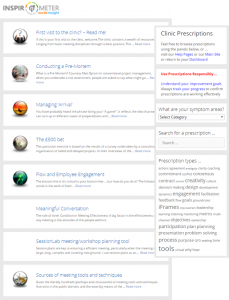 The key questions for an organisation progressing through Phase 3 are: Can we see real improvement trends? Is there much clinic activity/adoption? Is participation improving? Are there coaching programmes taking place? And is review systematically established?
The key questions for an organisation progressing through Phase 3 are: Can we see real improvement trends? Is there much clinic activity/adoption? Is participation improving? Are there coaching programmes taking place? And is review systematically established?
Key elements of Phase 3 include the adoption of a model of meeting effectiveness, to provide a practical structure and strategy for improvement, and active utilisation of the meetings clinic to explore and adopt elements of best practice within that.
Step 1 - Question: Develop a deeper insight into effectiveness
Objective: To appreciate the potential of meetings in their fullest sense, and to solicit fresh insight across these different aspects
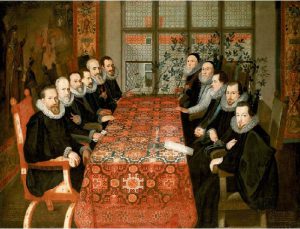 Our current paradigm of meetings has been an accepted and unquestioned modus operandi for so long, that we have largely lost our ability to treat it (or even see it) like the process it is. But it is a process, with inputs, and outputs, and options for converting one to the other.
Our current paradigm of meetings has been an accepted and unquestioned modus operandi for so long, that we have largely lost our ability to treat it (or even see it) like the process it is. But it is a process, with inputs, and outputs, and options for converting one to the other.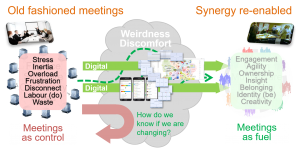 Sadly, traditional approaches to meetings are no longer fit for purpose in this regard. Their forms of presentation and debate are better suited to the era of management where relationships and responsibilities were largely stable. Conversely, leadership needs to deliver agility and requires meetings which generate energy, lift people up, empower them to do their best, and make them feel part of something bigger. They need meetings which utilise multi-channel, multi-sensory means of engaging more of people.
Sadly, traditional approaches to meetings are no longer fit for purpose in this regard. Their forms of presentation and debate are better suited to the era of management where relationships and responsibilities were largely stable. Conversely, leadership needs to deliver agility and requires meetings which generate energy, lift people up, empower them to do their best, and make them feel part of something bigger. They need meetings which utilise multi-channel, multi-sensory means of engaging more of people.
Step 2 - Experiment: Try out different ideas and approaches
Objective: Equip yourself with a richer understanding of what is possible in a meeting, and try out different ideas to achieve meeting effectiveness
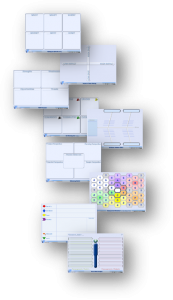 The good news is that the viable options required to adapt meetings to better support effective leadership are readily available. Many of them are already well known, all are within the public domain, and adopting them can be fun, energising, even releasing for people – leaders and participants alike. The meetings clinic is one source of these options.
The good news is that the viable options required to adapt meetings to better support effective leadership are readily available. Many of them are already well known, all are within the public domain, and adopting them can be fun, energising, even releasing for people – leaders and participants alike. The meetings clinic is one source of these options.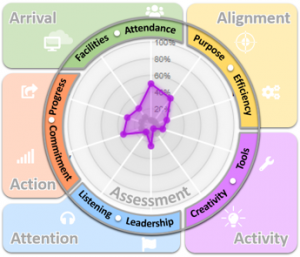 Furthermore, Inspirometer can be configured to look at a range of different meeting aspects, making it possible to gather more detailed meeting data almost effortlessly.
Furthermore, Inspirometer can be configured to look at a range of different meeting aspects, making it possible to gather more detailed meeting data almost effortlessly.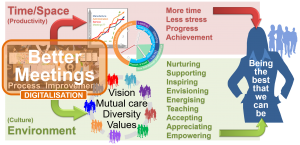 In terms of context, we need to get people to appreciate meetings in terms of their true importance to their own leadership identity. Viewed from a traditional management mindset, meetings are often simply a routine task or activity. But viewed from a leadership perspective they assume much greater importance.
In terms of context, we need to get people to appreciate meetings in terms of their true importance to their own leadership identity. Viewed from a traditional management mindset, meetings are often simply a routine task or activity. But viewed from a leadership perspective they assume much greater importance. And, in the same way as a master craftsman has a wide variety of tools which they are expert in handling, their own mastery of leadership will depend on their own set of meeting tools and their ability to select and apply the right one to bring about the changes in attitude and understanding that they are seeking.
And, in the same way as a master craftsman has a wide variety of tools which they are expert in handling, their own mastery of leadership will depend on their own set of meeting tools and their ability to select and apply the right one to bring about the changes in attitude and understanding that they are seeking. The growth of virtual meetings may be a real asset in this regard. The paradigm of existing meetings may be so strong in people that they resist the idea that their way of leading people in a room might be improved by new techniques. But, those same people might be more easily won over to the idea of how you might achieve the same ‘engagement’ in a virtual meeting. They may more easily accept that the new medium may (on occasion) be better served by new approaches – there is now widespread acceptance that process design should be reconsidered when it is computerised!
The growth of virtual meetings may be a real asset in this regard. The paradigm of existing meetings may be so strong in people that they resist the idea that their way of leading people in a room might be improved by new techniques. But, those same people might be more easily won over to the idea of how you might achieve the same ‘engagement’ in a virtual meeting. They may more easily accept that the new medium may (on occasion) be better served by new approaches – there is now widespread acceptance that process design should be reconsidered when it is computerised!
Step 3 - Engage: Nurture shared responsibility for improvement
Objective: Build a sense of shared responsibility for meeting effectiveness and for the strategies adopted (individually and collectively) to achieve it
-
Using in-meeting feedback and discussion to build shared responsibility for meeting improvement
-
Enabling participant feedback so that people can more accurately assess their contribution
-
Building ownership for a shared vision of meeting effectiveness through maturity models
-
Ensuring the blue-star-face feedback is only used for inspirational contributions
-
Engaging people in forums and discussions about the participant role and co-active leadership
 There is a big temptation to see meeting feedback as being an evaluation of the leadership of that meeting, and the risk arising from this is that the leader of the feedback will see that feedback as theirs (and sometimes even as personal) and this may reduce the likelihood that they will share it with the meeting participants.
There is a big temptation to see meeting feedback as being an evaluation of the leadership of that meeting, and the risk arising from this is that the leader of the feedback will see that feedback as theirs (and sometimes even as personal) and this may reduce the likelihood that they will share it with the meeting participants.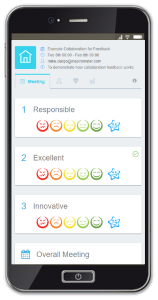
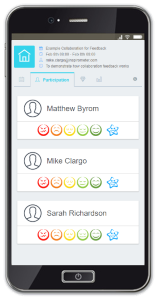 Just as the leader needs feedback on the meeting so they can identify issues, and objectively assess their progress in ensuring those issues are addressed, so people need the same sort of feedback on their behaviours, and for the same reasons. Sometimes we can be oblivious to the impact we are having, and even when we are mindful that our behaviour has fallen short in some way, we are frequently optimistic in terms of how often it happens and the extent of its consequences, as in: ‘its only rarely!’ or ‘it doesn’t really matter!’
Just as the leader needs feedback on the meeting so they can identify issues, and objectively assess their progress in ensuring those issues are addressed, so people need the same sort of feedback on their behaviours, and for the same reasons. Sometimes we can be oblivious to the impact we are having, and even when we are mindful that our behaviour has fallen short in some way, we are frequently optimistic in terms of how often it happens and the extent of its consequences, as in: ‘its only rarely!’ or ‘it doesn’t really matter!’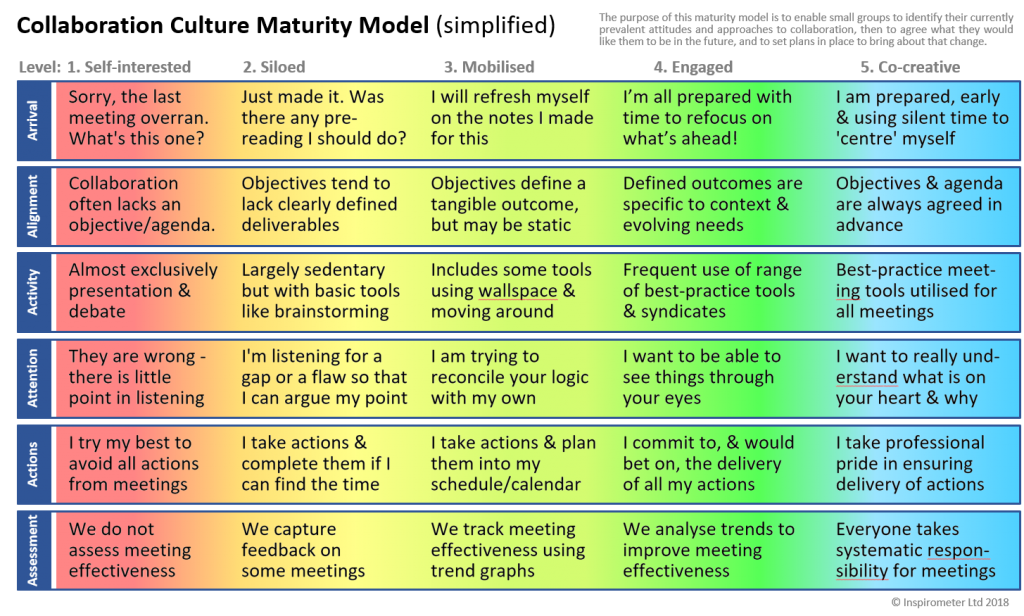
 It is important that people recognise that they should not give the blue star face in feedback unless their expectations really have been exceeded. The blue star face is intended to be motivational, in that people who receive it can rely on the fact that it means something significant – a recognition of an contribution that someone truly sees as inspirational or outstanding.
It is important that people recognise that they should not give the blue star face in feedback unless their expectations really have been exceeded. The blue star face is intended to be motivational, in that people who receive it can rely on the fact that it means something significant – a recognition of an contribution that someone truly sees as inspirational or outstanding.
Step 4 - Establish: Meetings as a driver of culture & performance
Objective: Develop sustainable practices for continuing to develop and grow meetings as an efficient enabler of creativity, culture and performance
 Inspirometer provides a set of top level organisational metrics which Executive Teams can use to augment their operational and financial metrics, and it is important that these become established as an integral element of the reporting and management process of the business. Top level Inspirometer metrics will show you (in real-time) the extent to which the relationships (formal and informal) within your organisation are enabling creativity, culture and performance, and this can help guide systemic strategies and/or local interventions to ensure those relationships best realise your collective potential to thrive in the emerging business context.
Inspirometer provides a set of top level organisational metrics which Executive Teams can use to augment their operational and financial metrics, and it is important that these become established as an integral element of the reporting and management process of the business. Top level Inspirometer metrics will show you (in real-time) the extent to which the relationships (formal and informal) within your organisation are enabling creativity, culture and performance, and this can help guide systemic strategies and/or local interventions to ensure those relationships best realise your collective potential to thrive in the emerging business context.
